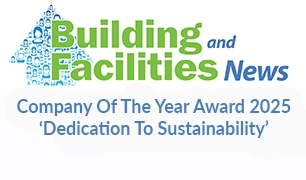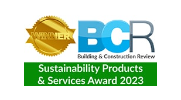Adveco reviews the uptake of technology for public sector sustainability across the built environment, focusing on water heating as a gateway technology…
The UK public sector is poised for significant change in the coming decades with a shift towards sustainable, adaptable, and technology-driven building projects to address sustainability concerns and shifting economic dynamics. By embracing innovation, and focusing on social impact, the UK construction sector has an opportunity to become a leader in shaping the future of public sector built environments.
Much focus has been placed on public sector sustainability imperatives, with the government and organisations stating it to be a paramount concern for new commercial buildings. This drives awareness and expected demand for energy-efficient designs that deliver buildings with low energy consumption through sustainable materials, renewable energy sources, and smart building technologies. Building design is also expected to be adaptable and future-proof to accommodate changing business needs and technological advancements. New buildings are also expected to deliver improved employee well-being and productivity through greater comfort with efficient building services such as air quality and heating,
This future will be shaped by a combination of economic factors and regulatory frameworks aimed at achieving the UK’s net-zero carbon emissions target by 2050. The previous government’s commitment to sustainability was underscored by policies such as the Clean Growth Strategy, the Ten Point Plan for a Green Industrial Revolution, and the Future Homes Standard. The new Labour government’s Green New Deal is a more ambitious policy framework for transforming the nation’s economy and infrastructure to achieve net-zero carbon emissions. This comprehensive plan targets various sectors, emphasizing large-scale public ownership and investment. Prime Minister Keir Starmer has stated this new government will be “builders, not blockers” announcing the formation of Great British Energy (GB Energy), a publicly owned company that will invest in renewables crucial to the transition away from fossil fuels. The expectation is for the Labour government to pledge substantially more investment in infrastructure, beyond the £600 billion over five years outlined in the previous Conservative government’s National Infrastructure and Construction Pipeline.
Enhanced regulations will mandate higher energy efficiency standards, encouraging the use of sustainable materials and construction practices. The updates to Part L (Conservation of Fuel and Power) of the Building Regulations will drive this shift, alongside certifications such as BREEAM (Building Research Establishment Environmental Assessment Method) and LEED (Leadership in Energy and Environmental Design) which will be increasingly important, driving the market for green commercial buildings.
The public sector, charged with government expectations to lead change from fossil-fuel dependency to renewables is a critical resource for understanding how successful the transition to net zero by 2050 will be in the UK. Healthcare and education in particular are expected to demonstrate significant growth in new building projects.
Schools and universities will play a leading role in the adoption of sustainable building practices and renewable energy. Universities will develop green campuses with energy-efficient buildings, renewable energy installations, and sustainable landscaping, with many tasked with providing sustainability models and strategies that will be filtered to schools and other education facilities. Those schools will then integrate sustainability and energy education into their curricula, fostering a culture of environmental responsibility among students. Crucially, there is an expectation for existing educational buildings to be retrofitted with energy-efficient technologies.
Hospitals and healthcare facilities will focus on reducing their environmental impact while maintaining high standards of care. This will demand prioritisation of energy-efficient designs, renewable energy use, and sustainable building materials. Hospitals will incorporate resilient energy systems, exploring options such as microgrids and battery storage, to ensure continuous operation during grid outages. Achieving green building certifications will be particularly important for healthcare facilities to demonstrate their commitment to sustainability and public health.
For the wider public sector environment, government buildings will need to lead by example in the adoption of low-carbon technologies and sustainable practices. To this end, the new government will be required to develop and enforce new policies that promote sustainable building practices and renewable energy use across all sectors and then provide significant public investment directed towards retrofitting government buildings with energy-efficient technologies and renewable energy systems. This building work will serve as demonstration projects, showcasing the benefits of low-carbon technologies and inspiring community-wide adoption.
As a specialist designer and supplier of hot water applications to the public sector, Adveco is at the forefront of evolving commercial-grade sustainable applications for the provision of hot water. Traditionally deploying gas as a fuel, water heating with its regular daily, often business critical demands, has been a major facet of a building’s energy consumption (as much as 30%) and therefore a key contributor to a building’s carbon emissions. For the past 15 years, the company has heavily invested in the development of low-carbon systems as well as more efficient gas-fired technologies. This work has encompassed the development of heat recovery systems, controls, solar thermal, electric water heaters, immersions, electric boilers and more recently air source heat pumps.
During this past decade, Adveco has recognised a singular governmental focus on sustainable housing, to the detriment of commercial and public sector buildings. This has been typified by poor or no clear advice, a lack of mandated policy and underfunding of the public sector. We recognise that retrofitting the UK’s existing building stock to be more sustainable is the greatest single challenge facing the construction industry and public sector alike.
Public Sector Sustainability 2019 – 2024
To better understand the challenge of achieving public sector sustainability Adveco recently commissioned research on the adoption of water heating technology across the public sector during the past five years. The research tracked more than 1500 projects during the period and clearly demonstrated the predominance of gas-fired water heating, accounting for 91% of all identified projects which included a wide variety of sites including schools, hospitals, local authority offices, prison service, police and fire.
Adoption of electric water heating remains generally low, especially compared to commercial organisations, while air source heat pumps are increasingly being specified, but uptake remains slow. Solar thermal installations were consistent and have started to show recent growth as recognition of its ability to actively cut operational costs of electricity-based applications and reduce carbon emissions for faster return on investment has influenced its specification. On many accounts, solar thermal was perceived as the easiest and most effective way of offsetting existing gas-fired systems for active investment in measurable sustainability.
The lower-than-expected uptake of heat pumps is initially surprising given the expectation that new builds will specify them. When questioning consultants and contractors, heat pumps will always be specified for heating, but most are realising that heating and hot water in many cases are best left separate, which from a design perspective makes absolute sense. Hybrid hot water systems are being specified for new build, but when dealing with retrofit the majority of those questioned confirmed that while initially leaning toward heat pumps, they were encountering problems with cost, infrastructure and design. As a result, specifications are being revised back to gas when connections are available. Reasons cited included it being much simpler, familiar, and cost-effective to replace and run, and new generation appliances were seen to be more efficient with lower carbon and NOx emissions. Most are also 20% hydrogen-blend ready out of the box so offer a future-proof option for the next 15 to 20 years.
Extrapolating from the adoption curves, the public sector is on the cusp of a profound transformation, driven by the urgent need to achieve net-zero carbon emissions by 2050. But the path so far has been winding, the process slower and more intermittent than expected. Dependency on gas is reducing, but its predominance across built environments cannot be understated. When specifying works on buildings there remains uncertainty over new technologies both in terms of capability and costs. An observed lack of clear government advice has also not helped to accelerate adoption in recent years. Electrifying buildings, the predominant aim currently, is also a costly undertaking, even with grant funding, and those costs can spiral if the technology in question is not familiar or fully understood. Poor design and engineering can therefore lead to even greater, unwarranted costs.
Compromises on systems are possible, and better data on water demands from metering a site is a great way to gain insight into applying the correct balance of technologies to achieve an application design that saves carbon from water heating for far less capital and operational investment as part of wider public sector sustainability strategies.
















